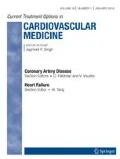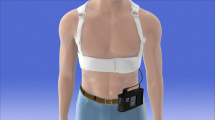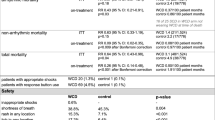Opinion statement
Cardiac arrest is a vexing public health problem. Fortunately, implantable cardioverter-defibrillators (ICDs) have been proven to decrease overall mortality in several populations at high risk for cardiac arrest. However, it is still unclear how to treat patients who have an elevated risk of cardiac arrest but are not in one of the identified high-risk groups proven to benefit from an ICD. It also is uncertain how to manage high-risk patients who have an accepted indication for an ICD but are unable or unwilling to have an ICD. In these clinical situations, the wearable defibrillator and automatic external defibrillator are options that should be considered. Both devices have been shown in small series to be highly effective at restoring sinus rhythm in patients with a ventricular tachyarrhythmia. However, there is still a lack of large-scale trials proving that these devices should be employed routinely in specific high-risk patient populations.
Similar content being viewed by others
References and Recommended Reading
Rosamond W, Flegal K, Furie K, et al.: Heart disease and stroke statistics-2008 update: a report from the American Heart Association Statistics Committee and Stroke Statistics Subcommittee. Circulation 2008, 117:e25–e146.
Chan PS, Krumholz HM, Nichol G, et al.: Delayed time to defibrillation after in-hospital cardiac arrest. N Engl J Med 2008, 358:9–17.
Moss AJ, Hall WJ, Cannom DS, et al.: Improved survival with an implanted defibrillator in patients with coronary disease at high risk for ventricular arrhythmia. Multicenter Automatic Defibrillator Implantation Trial Investigators. N Engl J Med 1996, 335:1933–1940.
Moss AJ, Zareba W, Hall WJ, et al.: Prophylactic implantation of a defibrillator in patients with myocardial infarction and reduced ejection fraction. N Engl J Med 2002, 346:877–883.
Bardy GH, Lee KL, Mark DB, et al.: Amiodarone or an implantable cardioverter-defibrillator for congestive heart failure. N Engl J Med 2005, 352:225–237.
Buxton AE, Lee KL, Fisher JD, et al.: A randomized study of the prevention of sudden death in patients with coronary artery disease. Multicenter Unsustained Tachycardia Trial Investigators. N Engl J Med 1999, 341:1882–1890.
Auricchio A, Klein H, Geller CJ, et al.: Clinical efficacy of the wearable cardioverter-defibrillator in acutely terminating episodes of ventricular fibrillation. Am J Cardiol 1998, 81:1253–1256.
Feldman AM, Klein H, Tchou P, et al.: Use of a wearable defibrillator in terminating tachyarrhythmias in patients at high risk for sudden death: results of the WEARIT/BIROAD. Pacing Clin Electrophysiol 2004, 27:4–9.
Reek S, Geller JC, Meltendorf U, et al.: Clinical efficacy of a wearable defibrillator in acutely terminating episodes of ventricular fibrillation using biphasic shocks. Pacing Clin Electrophysiol 2003, 26:2016–2022.
Caffrey SL, Willoughby PJ, Pepe PE, et al.: Public use of automated external defibrillators. N Engl J Med 2002, 347:1242–1247.
Page RL, Joglar JA, Kowal RC, et al.: Use of automated external defibrillators by a U.S. airline. N Engl J Med 2000, 343:1210–1216.
Valenzuela TD, Roe DJ, Nichol G, et al.: Outcomes of rapid defibrillation by security officers after cardiac arrest in casinos. N Engl J Med 2000, 343:1206–1209.
Sanna T, La Torre G, de Waure C, et al.: Cardiopulmonary resuscitation alone vs. cardiopulmonary resuscitation plus automated external defibrillator use by non-healthcare professionals: a meta-analysis on 1583 cases of out-of-hospital cardiac arrest. Resuscitation 2008, 76:226–232.
Marenco JP, Wang PJ, Link MS, et al.: Improving survival from sudden cardiac arrest: the role of the automated external defibrillator. JAMA 2001, 285:1193–1200.
Bardy GH, Lee KL, Mark DB, et al.: Home use of automated external defibrillators for sudden cardiac arrest. N Engl J Med 2008, 358:1793–1804.
Cram P, Vijan S, Fendrick AM: Cost-effectiveness of automated external defibrillator deployment in selected public locations. J Gen Intern Med 2003, 18:745–754.
Cram P, Vijan S, Katz D, et al.: Cost-effectiveness of in-home automated external defibrillators for individuals at increased risk of sudden cardiac death. J Gen Intern Med 2005, 20:251–258.
Author information
Authors and Affiliations
Corresponding author
Rights and permissions
About this article
Cite this article
Lee, B.K., Olgin, J.E. Role of wearable and automatic external defibrillators in improving survival in patients at risk for sudden cardiac death. Curr Treat Options Cardio Med 11, 360–365 (2009). https://doi.org/10.1007/s11936-009-0036-2
Published:
Issue Date:
DOI: https://doi.org/10.1007/s11936-009-0036-2




